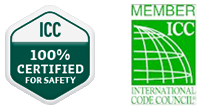Flood Plain Management
All areas adjacent to streams have a defined or implied floodplain. Within this floodplain, development is restricted and regulated.
In the 1970s, the Federal Insurance Administration (FIA) conducted detailed studies of many flood-prone waterways. These studies were significantly revised in 2007. If such a study was done, the floodplain is delineated on an official floodway map that indicates the stream channel, “500-year” and “100-year” floodplains. In the absence of such a study, the floodway is defined as the area including the stream channel and 50 feet landward from the top of the stream bank on both sides of the stream channel.
The National Flood Insurance Program (NFIP) is a federally based insurance program for property owners in flood prone areas. The NFIP is based on a mutual agreement between the federal government and the community. Federally subsidized flood insurance is available in those communities that agree to regulate development in their designated floodplains. The NFIP requirements provide the minimum basic guidelines for state and municipal regulations governing floodplain management and development. If the communities comply with the NFIP floodplain development criteria, federal flood insurance can be purchased for properties in the community.
Community adherence to these floodplain regulations is reviewed on an ongoing basis. If the community is found to still be adhering to the regulations, insurance rates stay the same. If the community is found to be in violation of the regulations, the insurance rates for all policy holders may go up or flood insurance may no longer be offered through the NFIP.
It is possible that you will need to demonstrate compliance to your community’s floodplain management ordinance before a building permit will be issued.
It is in the interest of all property owners within the floodplain to keep development and land usage within the scope of the floodplain regulations for their community. This helps keep insurance rates low and makes sure that the risk of flood damage is not increased by development of a property near yours.
These floodplain management regulations establish guidelines to make sure that development and land usage within the floodway and adjacent floodplain does not make flooding worse for everyone within the floodplain. The guidelines are used to prevent the creation of additional obstructions to flood waters and prohibit land fill that would divert excessive flood waters onto adjacent properties.
The floodway management regulations and Flood Insurance Rate Maps (FIRMs) were developed by the Federal Emergency Management Agency and copies are available either from them, PA DCED, or your municipal or county planning commission.
Flood Plain Maps & Links
Federal Emergency Management Agency
Map Service Center
P.O. Box 1038
Jessup, MD 20794-1038
Voice: (800) 358-9616
Snyder County Planning Commission
P.O. Box #217
Middleburg, PA 17842
Voice: (570) 837-4257
Fax: (570) 837-4345
Email: kstaschi@snydercounty.org
Union County Planning Commission
1610 Industrial Blvd., Ste 100
Lewisburg, PA 17837
Voice: (570) 522-1300
Fax: (570) 522-1329
Flood Plain Resources
Before starting your construction or development project, you must first check to make sure your plans are within the floodway management regulations for your area. Check with your municipality or call CK-COG to find out more.
Floodplain Management Fact Sheet
Flood Plain Management information sheet. This 290K PDF document is a good summary of the National Flood Insurance Program, basic floodway terms and why proper floodway management is important. You can visit the Susquehanna River Basin Commission website at: www.srbc.net.
Floodplain Management Regulations
PA Flood Plain Management Regulations Adopted Pursuant to the PA Floodplain Management Act (Act 166 of 1978) from PA DCED. 164K, PDF format.
Technical Information on Floodplain Management
Administrative Guidelines for Development. Technical Information on Floodplain Management from PA DCED , 2nd Edition Aug 2001. 221K, PDF format.


